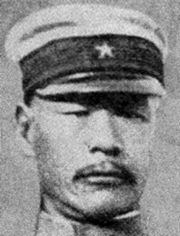Native name 一戸 兵衛 Rank General officer | Name Ichinohe Hyoe Years of service 1876-1920 | |
 | ||
Born August 2, 1855Aomori Prefecture, Japan ( 1855-08-02 ) Battles/wars Satsuma RebellionFirst Sino-Japanese WarRusso-Japanese War Awards Order of the Golden Kite (2nd, 3rd & 4th Degrees)Order of the Rising Sun (1st class)Order of the Sacred Treasures (1st class) Battles and wars | ||
Ichinohe Hyōe (一戸 兵衛, August 2, 1855 – September 2, 1931) was a general of the Imperial Japanese Army. A meticulous planner, the casualty rate of his command was far fewer than that of his fellow officers while achieving the same objectives.
Contents
Biography
Ichinohe was born as the eldest son of a samurai retainer in Tsugaru Domain (present day western Aomori prefecture). Ichinohe enlisted in the fledgling Imperial Japanese Army and was commissioned in 1876 as a second lieutenant in the 2nd Infantry Regiment. Serving with distinction during the Satsuma Rebellion between February–September 1877, Ichinohe was wounded in battle and later awarded the rank of full lieutenant in May of that year. In February 1878, he was transferred to the 1st Infantry Regiment.
During the First Sino-Japanese War, Ichinohe was commended for his actions while commanding the advance guard for the Ōshima Mixed Brigade at the Battle of Seonghwan on July 29, 1894 and later (as a lieutenant colonel) served as battalion commander in the IJA 5th Division at the Battle of Pyongyang on September 15, 1894.
In 1897, Ichinohe was promoted to colonel and was given command of the 4th Guards Regiment. The following year, he was promoted to Chief of Staff of the IJA 6th Division.
Ichinohe was promoted to major general in May 1901, and appointed commander of the IJA 6th Division. During the Russo-Japanese War, he served on the staff of the IJA 3rd Army, and was with Marshal Ōyama Iwao at the crucial Battle of Mukden. After the war, Ichinohe became commander of the prestigious IJA 1st Division and was promoted to lieutenant general in November 1907. He was subsequently transferred to command the new IJA 17th Division. In September 1911, he was transferred to the IJA 4th Division and in January 1912, he returned to the IJA 1st Division.
Ichinohe was appointed to the Supreme War Council in February 1915, becoming a full general from August the same year. In December 1915, he was appointed to one of the top three positions within the Imperial Japanese Army, that of Inspector-General of Military Training, holding that post until his retirement from active duty in June 1920.
Ichinohe was subsequently Principal of the Gakushuin Peers’ School from May 1920, and became a Shinto priest (kannushi) at Meiji Shrine from August 1924. In February 1926, he accepted the largely honorary post of President of the Japan Veterans Association. His grave is at the Tama Cemetery, in Fuchū, Tokyo.
